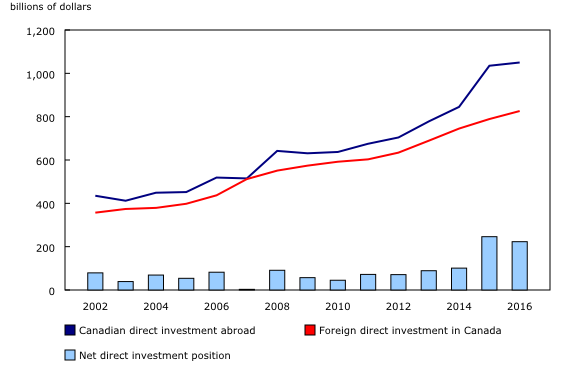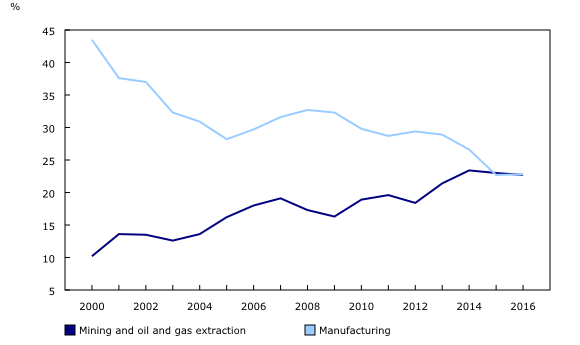Foreign direct investment, 2016
Archived Content
Information identified as archived is provided for reference, research or recordkeeping purposes. It is not subject to the Government of Canada Web Standards and has not been altered or updated since it was archived. Please "contact us" to request a format other than those available.
Released: 2017-04-25
Canadian direct investment abroad rose 1.4% to $1,049.6 billion in 2016. Following several years of strong growth, the stock of Canadian direct investment abroad increased at its slowest pace in six years in 2016, largely as a result of an appreciating Canadian dollar which moderated strong investment activity of $59.1 billion over the course of the year.
The stock of foreign direct investment in Canada increased 4.7% to $825.7 billion, mostly reflecting funds invested by foreign direct investors in existing affiliates. As a result, Canada's net direct investment position with the rest of the world narrowed by $22.3 billion in 2016, to $223.9 billion.
Growth in Canadian direct investment abroad held back by appreciation of the Canadian dollar
The slowdown in the growth of the stock of outward direct investment in 2016 was due to the appreciation of the Canadian dollar, which reduced the stock of Canadian direct investment abroad and offset most of the strong investment activity that took place during the year, led by mergers and acquisitions. The Canadian dollar gained ground against most major currencies in 2016, including the US dollar (+3%), the British pound (+19%) and the Euro (+6%).
On an instrument basis, the stock of Canadian direct investment abroad, in the form of equity, increased by 2.0% to $965.3 billion while the position in the form of debt instruments declined by 5.4% to $84.3 billion. Equity accounts for around 90% of the value of Canada's direct investment abroad.
Increases in North and South America mostly offset by declines in the rest of the world
The increase in the value of Canadian direct investment abroad in 2016 was mainly due to higher investment positions in North and South America, primarily the United States. This increase was partially offset by declines in the rest of the world, notably in Europe.
Following a 26.7% increase in 2015, the stock of direct investment in the United States was up a further 8.0% in 2016 to $474.4 billion. As a result, the US share of overall direct investment abroad had risen to 45.2% by the end of 2016, its highest level since 2008. Other countries in the Americas region with notable increases were Barbados, Brazil and Chile.
In Europe, the value of Canadian direct investment declined by 7.9% to $245.7 billion in 2016, mostly as a result of lower investment positions in Ireland and Luxembourg. The stock of direct investment also fell in the Asia and Oceania (-5.5%) and Africa (-22.5%) regions.
Foreign direct investment in Canada up on higher holdings from North America and Europe
The increase in the stock of foreign direct investment in Canada in 2016 was driven by higher holdings from North America (+6.0%) and Europe (+6.2%).
The United States was responsible for most of the increase in direct investment position from North America, rising 6.0% to $392.1 billion, while Switzerland and Netherlands accounted for most of the rise from Europe. These gains were offset in part by decreases in holdings from Asia and Oceania (-7.2%) and Africa (-20.1%).
On an instrument basis, foreign direct investment position in Canada, in the form of equity, grew by 6.2% to $673.0 billion in 2016, while the position in the form of debt instruments declined by 1.6% to $152.7 billion. Equity accounts for around 80% of the stock of foreign direct investment in Canada.
Increase in Canadian direct investment abroad concentrated in the transportation and warehousing and utilities industries
On an industry basis, the transportation and warehousing (+31.1%), utilities (+29.8%) and all other industry (+22.7%) categories recorded the most significant increases in the stock of Canadian direct investment abroad in 2016. This contrasted with declines in the real estate and rental leasing (-6.7%), mining and oil and gas extraction (-4.6%) and management (-2.9%) industries.
The finance and insurance industry remained the primary destination for Canadian direct investment abroad at the end of 2016 with a 36.6% share of the total position, followed by mining and oil and gas extraction with 18.5%.
Foreign direct investment in Canada up in most industries
The growth in the value of foreign direct investment in Canada was spread among most industries in 2016, led by wholesale and retail trade (+10.1%), manufacturing (+5.0%) and mining and oil and gas extraction (+3.2%).
Manufacturing remained the top industry for foreign direct investment in Canada with a 22.8% share at the end of 2016, just ahead of mining and oil and gas extraction with 22.7%. Since the year 2000, the share of manufacturing in the stock of foreign direct investment in Canada has almost halved, while that of mining and oil and gas extraction has doubled during the same period.

In celebration of the country's 150th birthday, Statistics Canada is presenting snapshots from our rich statistical history.
Data on foreign direct investment are available from 1926 and on a continuous basis from 1945. In the period immediately following the Second World War, the value of foreign direct investment in Canada was four times higher than the value of Canadian direct investment abroad. This began to gradually change in the mid-1970s as Canadian companies expanded their overseas presence. By 1997 the value of Canadian direct investment abroad exceeded the value of foreign direct investment in Canada, a relationship which has continued until the present day.
Note to readers
This is the annual release of detailed foreign direct investment data at book value. This release contains country and industry details for foreign direct investment that are drawn from the annual survey. This detailed information is not available at the time of quarterly international investment position releases. However, aggregates of direct investment positions, both at book and market values, are available as part of the quarterly international investment position release. The current aggregates at book value, along with revised aggregates at market value, will be integrated into the international investment position at the time of the third quarter 2017 release in December, in line with the Canadian System of Macroeconomic Accounts revision policy.
Direct investment is a component of the international investment position that refers to the investment of an entity in one country (the direct investor) obtaining a lasting interest in an entity in another country (the direct investment enterprise). The lasting interest implies the existence of a long-term relationship between the direct investor and the direct investment enterprise and a significant degree of influence by the direct investor on the management of the direct investment enterprise.
In practice, direct investment is deemed to occur when a direct investor owns at least 10% of the voting equity in a direct investment enterprise. This report presents the cumulative year-end positions for direct investment, measured as the total value of equity and the net value of debt instruments between direct investors and their direct investment enterprises.
Foreign direct investment by country and by industry
Following international standards, direct investment is based on the country of residence of the direct investor (immediate parent company) for foreign direct investment in Canada and on the country of residence of the direct investment enterprise (the immediate subsidiary) for Canadian direct investment abroad. This implies that direct investment is largely attributed to the first investor/investee country, rather than the ultimate investor/investee country. Direct investment is often channelled through intermediate holding companies or other legal entities in other countries before reaching its ultimate destination. Since these entities are generally in the financial sector, this sector accounts for a larger share of foreign direct investment on an immediate country basis than it would on an ultimate country basis.
Currency valuation
The value of Canadian direct investment abroad is denominated in foreign currency and converted to Canadian dollars at the end of each period for which a year-end position is calculated. When the Canadian dollar is depreciating in value, the restatement of the value of direct investment abroad in Canadian dollars increases the recorded value. The opposite is true when the dollar is appreciating. Foreign direct investment in Canada is directly recorded in Canadian dollars and the fluctuation of the Canadian dollar has no impact on the recorded value.
Data quality
In general, data for smaller countries and industries (defined as countries with foreign direct investment below $500 million or industries at the three-digit level of the North American Industry Classification System) are subject to higher sampling variability.
Contact information
For more information, contact us (toll-free 1-800-263-1136; 514-283-8300; STATCAN.infostats-infostats.STATCAN@canada.ca).
To enquire about the concepts, methods or data quality of this release, contact Marc Atkins (613-790-7339; marc.atkins@canada.ca), International Accounts and Trade Division.
- Date modified:



